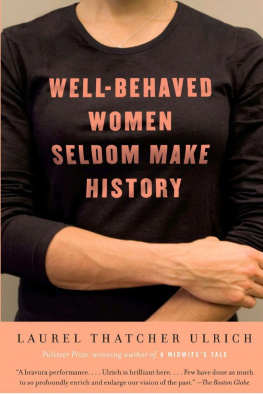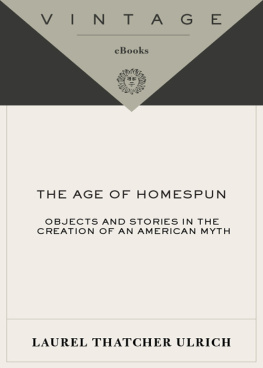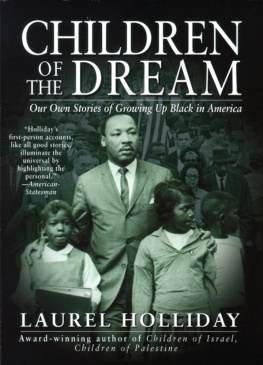ALSO BY LAUREL THATCHER ULRICH
A Midwifes Tale
The Age of Homespun
Well-Behaved Women Seldom Make History
A House Full of Females
All Gods Critters Got a Place in the Choir
(with Emma Lou Thayne)
Tangible Things: Making History through Objects
(with Ivan Gaskell, Sara J. Schechner, Sarah Anne Carter)
FIRST VINTAGE BOOKS EDITION, JUNE 1991
Copyright 1980, 1982 by Laurel Thatcher Ulrich
All rights reserved. Published in the United States by Vintage Books, a division of Penguin Random House LLC, New York, and distributed in Canada by Penguin Random House Canada Limited, Toronto. Originally published in hardcover by Alfred A. Knopf, a division of Penguin Random House, New York, in 1982.
A portion of this book was first published in Feminist Studies.
Vintage and colophon are registered trademarks of Penguin Random House LLC.
Library of Congress Cataloging-in-Publication Data
Ulrich, Laurel.
Good wives: image and reality in the lives of women in northern New England, 16501750 / Laurel Thatcher Ulrich.1st Vintage Books ed.
p.cm.
Reprint. Originally published: New York: Knopf, 1980.
1. WomenNew EnglandHistory. 2. WomenNew EnglandSocial conditions. I. Title.
[HQ1438.N35U471991]
305.420974dc2090-55673
Vintage Books Trade Paperback ISBN9780679732570
Ebook ISBN9780307772978
www.vintagebooks.com
v3.1_r1
FOR
Alice Siddoway Thatcher
Here lyes
A Worthy Matron of unspotted life,
A loving Mother and obedient wife,
A friendly Neighbor, pitiful to poor,
Whom oft she fed, and clothed with her store;
To Servants wisely aweful, but yet kind,
And as they did, so they reward did find:
A true Instructer of her Family,
The which she ordered with dexterity.
The publick meetings ever did frequent,
And in her Closet constant hours she spent;
Religious in all her words and wayes,
Preparing still for death, till end of dayes:
Of all her Children, Children livd to see,
Then dying, left a blessed memory.
Anne Bradstreet, 1643
Contents

Historical maps will be found on
Illustrations

following
Portrait of Catherine Moffatt, by John Greenwood
Portrait of John Moffatt, by John Greenwood
Portrait of Elizabeth Oliver, by John Smibert
Portrait of Daniel Oliver, by John Smibert
Portrait of Abigail Gerrish and Abigail Gerrish, granddaughter
and grandmother, by John Greenwood
Preface

I N SEVENTEENTH-CENTURY N EW E NGLAND , women of ordinary status were called Goodwife, usually shortened to Goody, as in Goody Prince or Goody Quilter or Goody Lee. The title of this book deliberately puns on that term. To write about good wives is to write about ideals; to write about goodwives is to write about ordinary women living in a particular place and time. I have tried to mediate between the two concerns, to explore values and at the same time to describe and to celebrate lives. The title consciously echoes Alice Morse Earles Colonial Dames and Good Wives (Boston, 1895), honoring an early generation of womens historians who skillfully practiced what later scholars dismissed as pots-and-pans history.
My emphasis on good wives betrays a propensity to search for normative elements in a history which from the time of Hawthorne has been dominated by outcasts and witches. Readers will find little about Anne Hutchinson or the Devil in this book. They will find much about housekeeping, childbearing, and ordinary churchgoing, about small conflicts experienced by forgotten women, and about little triumphs that history has not recorded.
Good Wives is a study in role definition, an extended description constructed from a series of vignettes. In organization and intent it is a little like those elongated samplers worked by young women in seventeenth-century England and America. Unlike eighteenth- and nineteenth-century samplers, which were made to be framed and hung on a wall, these first samplers were true patterns, one band of embroidery added to another, each incomplete in itself but capable of transfer and elaboration on a larger ground. In the best of samplers, and I hope in this book, the appeal of the whole lies in the aggregate texture of the associated parts.
I have written about northern New England because that is where I live and the tedious sifting of sources necessary for such a project was therefore possible, but I make no special claim for the regions uniqueness or cohesiveness. I suspect that much of what I have discovered can be found elsewhere. Good Wives describes a diverse and changing world, but its major objective is neither to elaborate nor to explain change but to delineate certain broad patterns within which change occurred. I offer it as a collection of ensamples, a parade of exemplary lives, which, if not constructed in quite the medieval sense, have something of the same intentto entertain and to instruct the reader.

I owe a special debt to Charles E. Clark, whose seminar on the historical writing of early America, which I took when a graduate student in English, reinforced my growing interest in history, and who first suggested what seemed at the time an awesome change in direction. I am pleased in having had him as my mentor. I am also fortunate in having had the guidance of Darrett Rutman, also of the University of New Hampshire. He has been a rigorous critic and an equally generous friend. For moral support and good ideas I am indebted to other colleagues at U.N.H., Karen Andrsen, Robert Mennel, Judith Silver, Steve Cox, Ray Wilbur, Ron Lettieri, Chuck Wetherell, and Stuart Wallace, all of whom have read and commented on portions of the manuscript. Mary Ryan offered helpful criticism of an article from which several chapters grew; Mary Maples Dunn generously read and responded to a late version of the manuscript; Claudia Bushman has continuously shared her appreciation of the ordinary. I thank all of these friends and critics without blaming any.
I would like to thank the directors of the Essex Institute in Salem and the Massachusetts Historical Society in Boston for permission to quote from unpublished manuscripts in their collections. I am also grateful to Irene Norton of the Essex Institute; Elizabeth Newton and Mary Conley of the Ipswich Historical Society; Elizabeth Barker and Margaret Kimball of the Warner House in Portsmouth, New Hampshire; Susan DeVito of the Lady Pepperrell House at Kittery Point, Maine; Mrs. Everett Billings of Kittery Point; and the Reverend Mr. James Christensen of South Berwick, Maine, for special assistance in locating materials.










